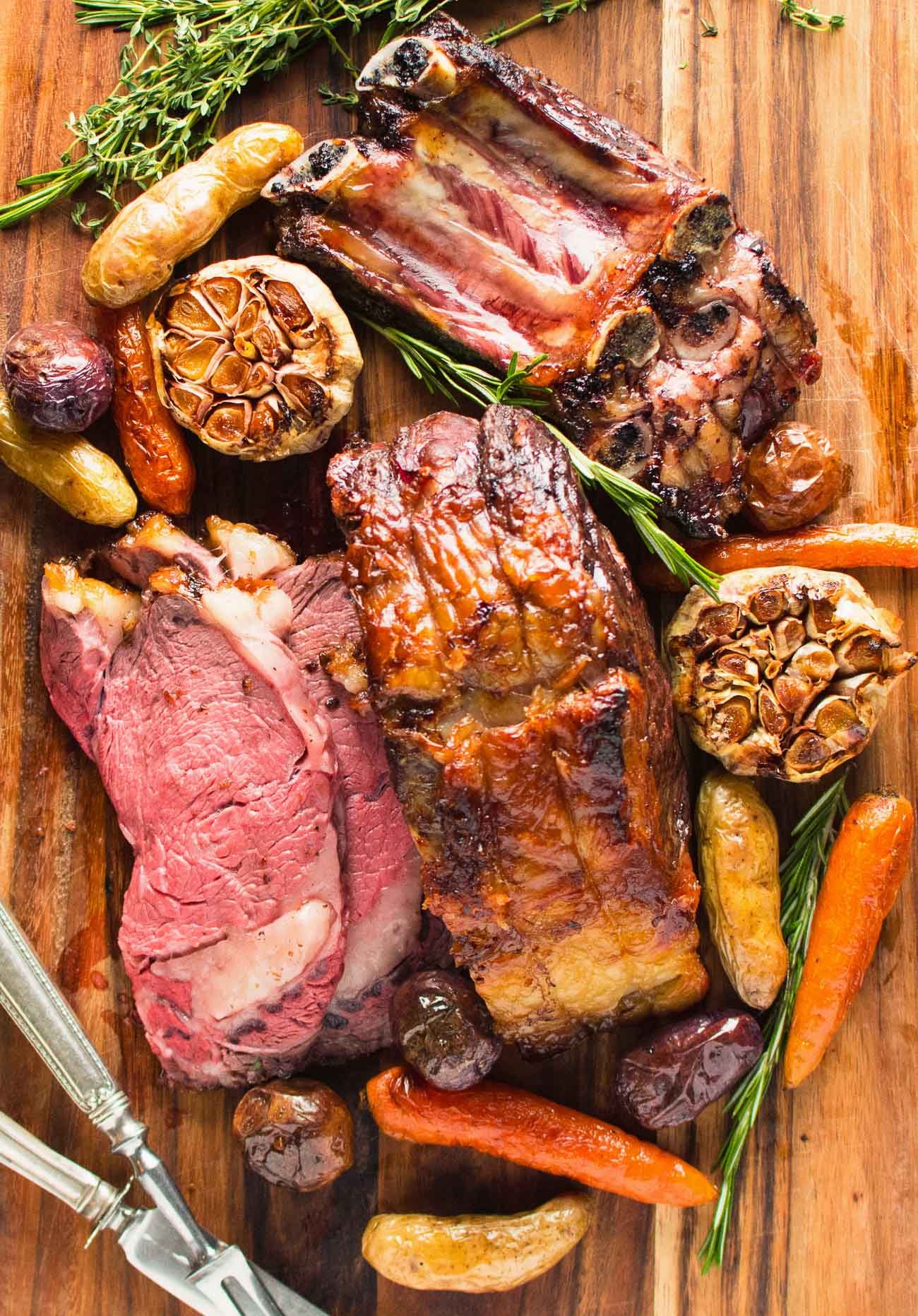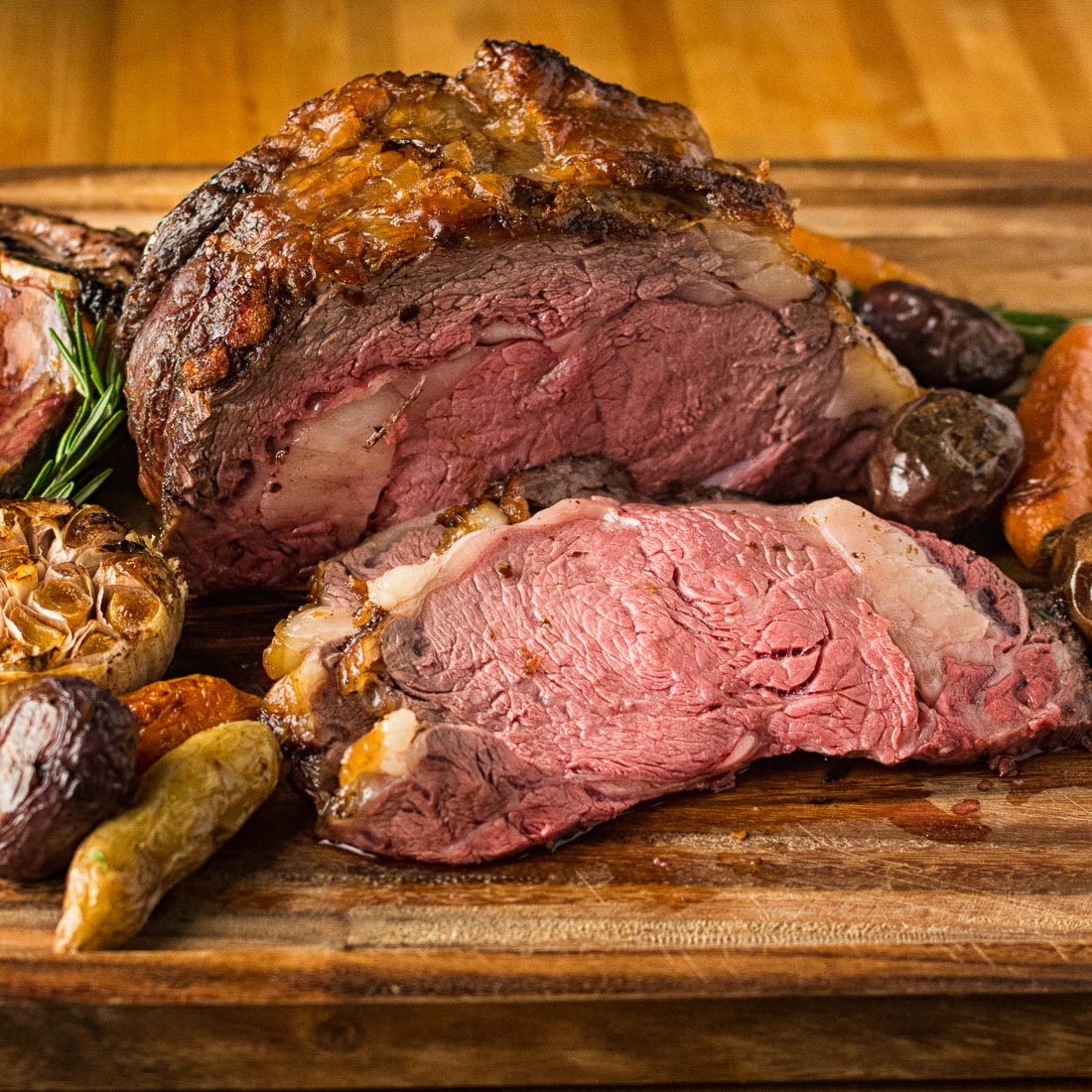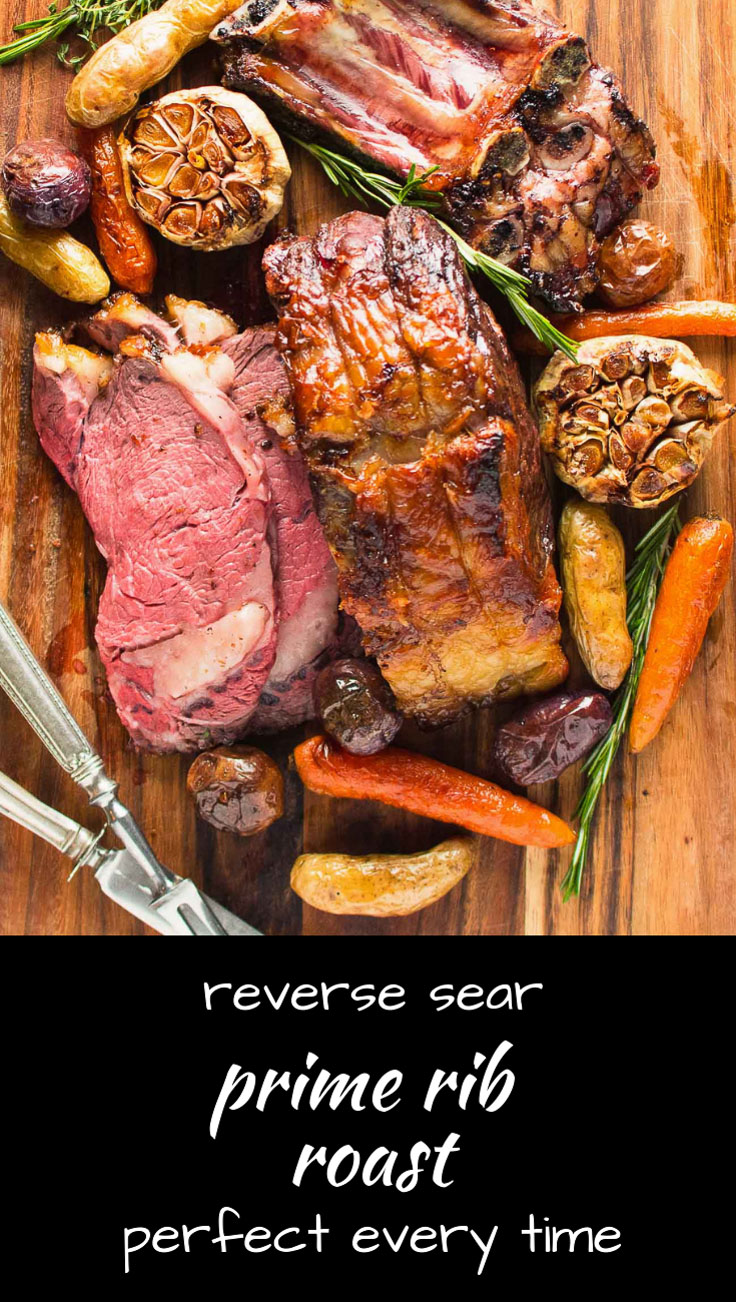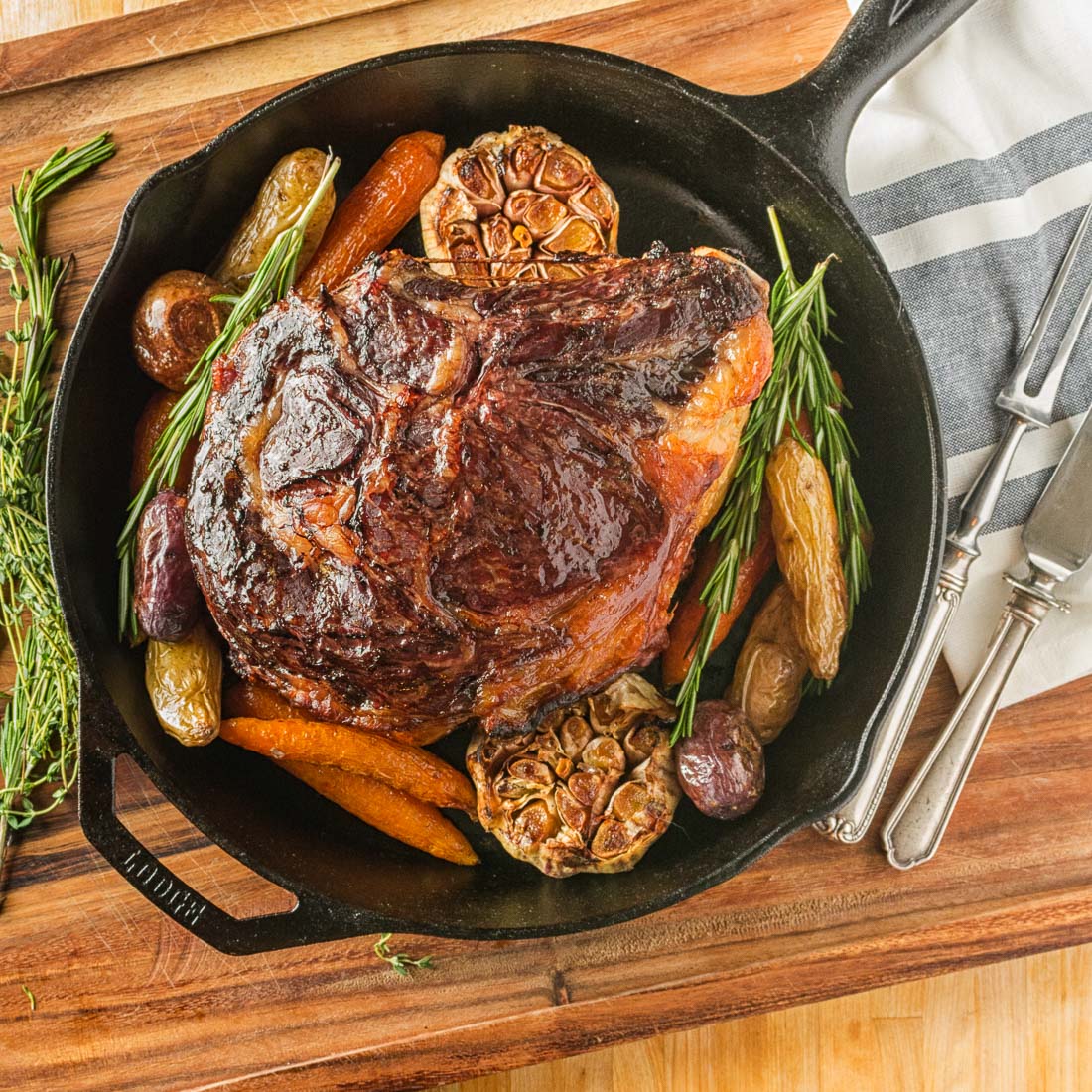I love a good prime rib roast. You know – deeply brown and crispy on the outside. Perfectly cooked the whole way through. No sign of grey meat. That’s the dream. Reverse sear prime rib makes that dream a reality.
It’s the exact same as reverse sear steaks but on a bigger scale. A grander scale. And this is how you do it. This is the Serious Eats prime rib recipe. If you want more details that’s where you’ll find them.
A few simple steps
There’s a few steps involved to reverse sear prime rib. First, unwrap your prime rib and let it air dry for a day or two in the fridge. Just make sure you don’t bump other things into it and you’ll be fine.
Then cook it low and slow in a 225F oven. This takes time but it is time well spent. It took almost 3 hours for a 2 rib roast. For a big one plan on 4 or more hours.
Pull it from the oven when the internal temperature hits 125F. Let it rest for 30 to 60 minutes. Crank your oven to as high as it will go – like 500F – and let it pre-heat.
Return the rested prime rib to the oven and blast it for 10-12 minutes to crisp up and really brown. Done. Perfectly done.
Make the gravy
There’s one problem with reverse sear prime rib. And it’s a big one. Everything comes at a price. In this case the price is no fond in the bottom of the pan. No beautiful little flavour bombs to make your gravy.
Luckily there’s a way to fix that. Sort of. It won’t be as good but it will work.
If you can get some demi-glace, that fixes the problem nicely. Just add it into your gravy. Problem solved. If you can’t you have a bit more work to do. Demi-glace isn’t that hard to make but it takes time.
Make a roux with some of the fat in the pan and about equal volume of flour. Add the best beef or veal stock you can find or make.
Concentrated veal stock works really well here. Season it with salt and pepper. Or you can just serve the prime rib sprinkled with a bit of fleur de sel. That works too.
At the end of the day you have a choice to make. Roast your prime rib at 325F and live with the grey meat on the outside. You’ll get a great gravy.
Or, do the reverse sear and serve it with a gravy that’s not quite as good. Tough decision? I don’t think so…
reverse sear prime rib
Ingredients
Quantities depend on the size of your roast
- 1 prime rib roast - 2-4 ribs
- salt
- pepper
- 1/4-3/4 cup red wine
- flour
- 1-3 cups really good beef or veal stock
Instructions
One or two days before roasting
- Unwrap your prime rib. Place it on a cookie sheet, ribs down and let air dry for 1-2 days.
To roast your prime rib
- Pre-heat your oven to 225F.
- Place the roast in an oven proof dish (it will need to withstand 500F at one point) and place it in the 225F oven.
- If you have a thermometer with a remote probe place it in the centre of the roast. If you don't then start checking internal temp after 2 hours. You are shooting for 125F internal temperature.
- When you get to 125F remove the roast from the oven. Let your roast rest for 30-60 minutes while your oven heats to 500F.
- While your oven is heating start preparing your gravy.
- Add the red wine to a saucepan and simmer briskly until reduced by half. Add your stock and reduce slightly.
- After the roast has rested for 30-60 minutes return it to the oven and blast it for 10 minutes to brown and crisp up.
- Remove from oven and remove roast from the pan. Spoon off all but 2-4 Tbsp of beef fat.
- Place pan on medium low heat. Add half as much flour as you left fat in the pan. If you have 2 Tbsp of fat, add one Tbsp of flour. Make a roux by stirring the flour and fat together. Cook, stirring constantly for about 1 minute. Add the warm stock/red wine mixture slowly, stirring constantly. Bring to a simmer. Adjust seasoning.
- Carve the bones out of the prime rib and cut into slices across the grain. Serve with gravy.






Hi. Love the reverse dear method. Only doing a 3lb prime rib this year. How long do you suggest to cook to get to 130? Thank you.
There are too many variables for me to risk guessing. Thickness of the roast. Size of the roast. Cap on or off. Accuracy of your oven. I would suggest you start checking internal temperature after no more than one hour with a small roast. If it’s a big one rib roast (so fairly thin) I’d start even sooner than that. That’s a tricky size.
Do you recommend using the convection or conventional setting on the oven? If using the convection, do you lower the cooking temp?
For the long slow cook it depends a bit on your oven. You want even heat to get that edge to edge consistent finished product. Maybe try both with nothing in the oven and use an IR gun if you can get one to see what’s going on? For the high temp sear I would definitely use convection. The faster you get the crust the less it will cook into the meat.
With your recipe above, is your final serving temp 130 degrees or higher?
For prime rib I generally go for about 130F. Kind of rare to medium rare is what I’m after.
Thank you Romain. I will build two timetables into the serving times just in case the roast starts to carryover too much.
How much carryover cooking occurs with the rest you describe? If pulled out at 125, what is the temp right before blasting in the oven after the rest, and then what’s the final temp after the blast?
I will be cooking a 5 bone prime grade roast and would like a final serving temp of 135.
I have had varying degrees of carryover temps throughout the years. I would prefer a 30 minute rest window.
Unfortunately this is a tough one to build a comprehensive table around. As much as I love it I can only eat (and afford) so much prime rib. You aren’t going to get a big lift like you would at a higher roasting temp when you pull it out of the oven the first time. It will stabilize as it rests and the final blast of heat will probably push it up somewhere around 2-5 degrees.
There are so many variables though. Cap on. Cap off. Where on the rib it comes from on the cow (thickness/diameter), accuracy of your oven, accuracy of my oven. I use an IR gun so I’m pretty confident of my temps but there is variability when I measure between the sides and the back as well. I get results like the picture every time but I also don’t get to do 5 rib prime ribs very often.
I’m sorry I don’t have a better answer for you. A five rib prime rib is serious business and the last thing I want is for things to go sideways for you because I wasn’t 100 percent forthcoming…
About the fond problem, would it be advisable to transfer the roast to another pan for the high-heat sear, and thus have the fond from the slow roast to make your gravy?
The problem is it doesn’t really throw much of a fond at all. There’s a bit after the high-heat sear but not enough to make a really good pan sauce. This year for Christmas I’m trying a hybrid approach. I have a small roast that I will cook with some diced onions. I’m going to try roasting it at 325F to medium rare. The little roast will wind up being sandwiches I think.
I will deglaze the pan and take those onions and fond, put them in with whatever fond I get from the reverse sear prime rib. Add veal stock. Let that simmer a bit, strain and thicken with a bit of arrowroot. Maybe enrich it with a touch of butter. I’m hopeful I get decent jus that way.
Got it! Good idea about the little roast, might have to go pick one up and try that, or mix in a Better than Boullion concoction if no other option. Thank you for responding so quickly and Merry Cooking.
I’m cooking a 22 pound prime rib roast. Would like it at rare to medium rare. Using the reverse sear method what temp do you recommend? Can’t wait to try this!!
I would stick to the recommended 225F temperature. That gives you the even edge to edge doneness.
It’s impossible to say how long it will take though. There are a lot of variables. Cap on or off. Size (diameter). What temperature the roast was went into the oven. Convection or not. How precise your oven thermostat is etc. It won’t be as spectacular but consider perhaps cutting it down to two roasts to reduce cooking time and help ensure even cooking.
How funny- we also have a 22 lb roast this year! Never cooked one that large before, but we’ve used this cooking methodology in the past with great success. I’ve decided to focus the rare temp (using a probe) on the large end of the roast and let the smaller end be more done (we have family members that like it medium to well). Hopefully everyone will get what they like!
You guys are going to have a spectacular Christmas dinner! 22 lbs. That’s some serious stuff.
I’ve tried this method – works great. Have you ever slow roasted it and then seared it the next day? I’m in a situation where I don’t have time to roast it but could do it a day ahead, put it in the fridge, set it out to room temp and then sear. Would it still be cold in the middle?
I’ve never tried that. Pretty sure it would still be cold in the middle. Especially if it’s a big roast. That’s a tough one. I’m sorry I don’t have an answer for you.
I am so excited ,I have been on Pinterest all week trying to find the perfect prime rib recipe I have spent 94 dollars on this roast and I want the best for it. I will try the reverse sear and I will let you know this is a very special nite my wife returned from active duty military and I want the most romantic dinner I could possibly afford , I will let you know how this recipe is
Sounds like it will be a wonderful night.
If we want it med should we take it out of the oven @ 130 internal? Once out of the oven will it continue to cook? We are using a 2-1/2 lb roast in a convection oven set at 200 degrees.
It may continue to cook out of the oven although at 200 degrees oven temp it won’t come up much, if at all. I’ve never tried this with such a small roast and I never take beef past medium rare. 130F is probably a good bet but keep a close eye on the internal temp as you sear it.
I was thinking about putting the roast in the Sous Vide at 50C for about 3 hours then putting it on the rotisserie in a very hot BBQ full of wood smoke for 15 minutes to add a bit of smokiness and crisp the skin up. Unfortunately like your plan, there will be no fond at the bottom of the pan. I’m going to try putting a pan under the roast in the BBQ as it turns and see what I get.
Great idea. I have never managed to get a fond from the high heat blast but I bet the crust from the rotisserie will be amazing no matter what. Only concern I would have is that if it does pick up smoke it will limit what you can do to create sauce. I don’t think pan sauce and demi glace would work – as an example. But I really like the rotisserie idea. Will try that next time for sure…
I am planning a dinner where I will prepare a 15 lb prime rib. Would you possibly have an idea of how long that will take if cooking to medium rare?
I have never tried such a big roast. I would guess somewhere between 4-5 hours. There is 30 minutes of wiggle room in the resting period that you could probably stretch a bit so I would budget 4 and 1/2 hours of low roasting time with 30-75 minutes of resting time before the final sear. Remember that whatever happens, you need to pull it at the desired internal temperature. Time is a guideline. Internal temperature is the real metric and 125-127 should give you a pretty even medium rare (like the pictures). Good luck. I’m sure it will be a fantastic dinner party.
This looks incredible!
Thanks Lucy. Very kind of you to say…
Preparing prime rib at home has always scared me, I’m terrified that I’ll mess up this beautiful cut of meat! Thanks to you, I’m not afraid anymore! Your technique to reverse sear the prime rib looks and sounds amazing! Thank you so much for such a detailed recipe, I can’t wait to make this on Valentine’s Day!
I’m so glad you are trying it. Happy Valentine’s Day!
That beef looks so buttery and perfectly done! Wow I mean wow. I am speechless and I need to go pick up a prime rib this week. haha
Thanks Joyce. Anyone can do it – stick it the oven and wait, and wait, and wait. It is pretty fool proof if you have an instant read thermometer.
This looks incredible!! I wish I had a bigger freezer so I could make batches of your veal stock. How to cook prime rib has always been a question of mine and I love your tutorial. Time to make this so I can serve it up with some horseradish. 🙂
Thank you! You don’t need a big freezer to make the concentrated veal stock. That’s the beauty of it. You reduce it right down to almost nothing. A full batch is about 2 ice cube trays worth. Takes almost no room at all.
I hope you like it. Like I said, it’s a bit of a tradeoff. Perfect beef or perfect gravy…
Will absolutely try!